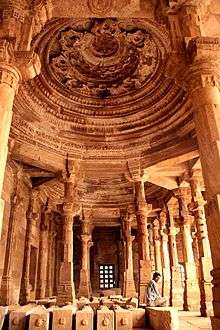Jami Mosque, Khambhat
Jami Mosque is a mosque in Khambat, Gujarat, India, built in 1325. It is one of the oldest Islamic monuments in Gujarat.[1][2] The mosque's interior has colonnaded open courtyard built with 100 columns.[3][4]
| Jami Mosque | |
|---|---|
Jami Masjid Complex, Khambhat | |
| Religion | |
| Affiliation | Islam |
| Status | Active |
| Location | |
| Location | Khambhat |
| State | Gujarat |
| Geographic coordinates | 22.310281°N 72.618017°E |
| Architecture | |
| Architect(s) | Umar bin Ahmad al-Kazaruni |
| Type | Islamic |
| Style | Indo-Islamic architecture |
| Groundbreaking | 1325 |
| Specifications | |
| Minaret height | No minaret |
| Materials | Ancient Monuments remains |
Location
The Masjid is located in Khambat or Cambay, which was a prosperous mercantile port town during the 7th to the 18th century. It is at the estuary of the Mahi river. It is 100 kilometres (62 mi) away from Ahmedabad and 78 km away from Vadodara, Gujarat.[3][4]
History
Alauddin Khalji (1296–1315) invaded Gujarat and captured Khambat in 1324.[3] During his invasions in Gujarat he had destroyed many Hindu and Jain temples. According to an inscription on the mosque, it was built in 1325 AD from the ruins of the earlier monuments. Umar bin Ahmad al-Kazaruni, a businessman of the town, is credited with building the mosque. This structure is a congregational mosque which marks the start of Islamic architecture in Gujarat and is distinct in style.[4][5]
Architecture

The mosque's architecture marks the evolution of the Indo-Islamic architecture.[2] Its architectural features do not display any minarets but toranas are seen in the central arches of the mosque which represent architecture of the Gujarat Sultanate.[5]
The interior part of the mosque has a colonnaded open courtyard which is built with 100 columns supporting roofs built from the ruins of Hindu and Jain temples.[6] The prayer hall has many compartments topped by low domes, which are unique and are different from those which crown the mihrab's niches. The domes are provided with latticed windows made in the architectural style of Gujarat.[3][4] The columns are set in two rows with each row consisting of 26 columns forming a passage that separates the wall in the front from the first row. In addition, there are eight rows formed by six pillars in each row, which are next to the facade; these result in the formation of 14 chambers and each chamber is topped by a dome.[6] There are arcaded entrances to the aisle of the mosque which are provided with a flat roof. In the middle portion of the mosque which hides the domes of the roof, there are jambs which rise to a height of about 40 feet (12 m) and these are topped by sharp finials.[3]
.jpg)
In the southern part of the mosque there is a colonnaded hall in a square shape but with a circular inner court where the tomb of Umar bin Ahmad al-Kazaruni, who died in 1333, is located. It is built of marble. In addition, there are many smaller tombs of the 14th and 15th centuries. There are also remnants of a fort built by the Mughal Emperor Akbar in the 16th century.[4] There are many engravings on various parts of this tomb structure such as the first twelve and a half verses of the Surah XXXVI, Surah II, v. 256 – the Throne-verse," the conclusion of verse 151 of Surah II, Surah XXXVI, v. 52, Surah III,vv. 16 and 17 and Surah vv. 163–165. On the western part of the tomb is the Epitaph which has an inscription of Surah XXXVI, vv. 65–71.[7]
References
- Series-3 Indian History. Pratiyogita Darpan. pp. 78–.
- Gujarat (India) (1977). Gazetteers: Kheda District. Directorate of Government Print., Stationery and Publications.
- "Pavilion in the court of the Jami Masjid, Khambhat (Cambay)". Online Gallery of British Library. Retrieved 12 April 2016.
- Jonathan M.. Bloom; Sheila S.. Blair (2009). The Grove Encyclopedia of Islamic Art and Architecture. Oxford University Press. p. 1. ISBN 978-0-19-530991-1.
- Anjali H. Desai (2007). India Guide Gujarat. India Guide Publications. pp. 203–. ISBN 978-0-9789517-0-2.
- "View from the south end of pillars in the interior of the Jami Masjid, Khambhat (Cambay)". Online gallery of British Library. Retrieved 12 April 2016.
- "Omar bin Ahmad Al Kazaruni's Tomb in the Jami Masjid, Khambhat (Cambay)". Online Gallery of British Library. Retrieved 12 April 2016.
| Wikimedia Commons has media related to Jami Masjid, Khambhat. |